John Deere is a particularly favorite subject or ours. As we noted HERE, our DeKalb shop was a John Deere supplier for 25 years. In answering who owns John Deere, we're going to rip the Band-Aid off quickly on this one. Deere & Company, doing business as John Deere, is a publically traded company, and the largest shareholder is Bill Gates. Yes, the same Bill Gates who's also one of the largest owners of farmland in America. Now that we have that out of the way, let's get to the more fascinating history of who John Deere was, a blacksmith from Vermont, a staunch abolitionist raised by a single mom, and the man who changed the face of farming for the entire planet.
BRAVE NEW WORLD
In 1804, the United States of America was 27 years and 7 months old when John Deere, the third son of William Rinold Deere and Sarah Yates, was born. It's the same year Thomas Jefferson commissioned the Lewis and Clark Expedition. William first immigrated from England to Quebec, Canada in the 1790s before coming to the U.S. He married the daughter of Captain James Yates, a British Cavalry officer from Portsmouth, England. William was a merchant tailor by trade, and wife Sarah was an accomplished seamstress. So it came when young John was just 4 years old, his father sailed to England to help secure supplies and funding, but on his return, his ship was lost at sea and Sarah was left to raise the children on her own.
Because of their proximity to our DeKalb shop, the pics for this blog post come from the John Deere Historic Site in Grand Detour, Illinois
It’s important to note the state of the country at the time of John’s formative years. Even though the United States was officially formed in 1776, before the Articles of Confederation were adopted in 1781, the Continental Congress was the chief governing body and the first President was Peyton Randolph. (Side note: George Washington was the first president post-Continental Congress from April 30, 1789 to March 4, 1797.) Historically speaking, the Continental Congress was, for lack of a better term, a mess. The American Revolutionary War (1775-1783) was expensive, but successful. If you’ve seen Hamilton, you know King George III was somewhere singing “You’ll be Back.” With that success, came more conflicts with the French in the Quasi-War (1798-1800), the Barbary Wars (1801-1805, 1815), and the War of 1812 (1812-1815). America was bleeding money.
TRICKLE-DOWN DEBT
To counteract the labor involved with paying with gold, silver, and copper, private banks would issue bank notes what were easier to use as cash. As there simply was not enough banks and bank notes to meet demand, finance has migrated to a debt system where one could run a tab on what’s owed and then settle that debt sometime in the future. Much to the dismay of Alexander Hamilton, the United States was not doing well in managing money federally, and trickle-down debt became a problem for the colonists. Andrew Jackson vetoed rechartering of the Bank of the United States, insisting on distributing federal funds to smaller, private banks. Within a short amount of time, hundreds of banks popped up literally printing their own money.
Pictures taken at John Deere Historic Site in Grand Detour, Illinois
Contrary to popular belief, debts weren’t settled at regular intervals. Many people would try to settle for the new year, but mostly debts were settled when they could, sometimes running years without being fully settled in full. This is how the 7th Amendment of the Bill of Rights came to be, ratified on December 15, 1791 - “In Suits at common law, where the value in controversy shall exceed twenty dollars, the right of trial by jury shall be preserved.” ($20 in 1791 is equal to $660.27 today.) This meant that business owners were constantly in a state of missing finances, while the customer was stuck in a hamster wheel of debt, and the courts wouldn’t touch disputes under 20 dollars. All of this debt was mounting while the United States was trying to gain independence from Britain while fighting off the French and Spanish, while waging war on Seminoles (1817-1818), and Sauks, Meskwakis, and Kickapoos in the Black Hawk War (1832).
Email Subscribers: Use code LGLG for 20% off this weeks select wares.
In 1821, during this upheaval, John Deere left his eduction at Middlebury College at 17 years old to apprentice for Captain Benjamin Lawrence, a successful Middlebury blacksmith. His mother, Sarah Yates Deere, passed away in 1826, and John decided to venture on his own blacksmithing business on his own. The next year, our dear John married Demarius Lamb, and the two had nine children over the next 23 years. At the end of this blog, there's a comprehensive list of the children made possible by the John Deere Historic Site.
CLINKERS AND PLOVERS
John was finding himself falling deeper and deeper into debt. He and his growing family moved around trying to make money, which was hard as there were more blacksmiths available than there were items to ‘smith’. It didn’t help that two of his shops burned down, making it impossible for him to pay back creditors. Deere decided to venture west in 1936, spending time in Chicago when he received news that Grand Detour (locally pronounced with a French accent) - a village of about 400 at the time - had no blacksmiths, and the farmers of the area desperately needed someone for repairs. John scoped out the area, found space, and set up a forge and shop. The next year Demarius, her pregnant sister, Lucretia, her husband John Peek, and a total of 12 children trekked across the midwest to join John Deere and his new 1,378-square-foot blacksmith shop in Illinois just as the Great Panic of 1837 collapsed the economy of New England.
Wood, cast iron, and steel plows on display at John Deere Historic Site in Grand Detour, Illinois
John was doing very well as a general repairman and blacksmith for Grand Detour while also managing to manufacturing basic tools like shovels and pitchforks. The tilling plows that Deere worked on were made of wood or cast iron, similar to those popularized by Jethro Wood. In both cases the plow would collect soil, get stuck and needed cleaning at regular intervals. So, according to legend, Deere repurposed a Scottish steel saw blade from mill owner named Leonard Andrus, a fellow pioneer from Vermont. Deere was able to forge the broken blade into a smooth, shiny plow that cut through the soil without sticking or caking, even in damp or wet ground. As a refresher from chemistry class - Iron is a naturally-occurring element that's a metal while steel is an alloy of iron and carbon.
Harking back to the debt-stacking problem that collapsed his home state, Deere was finally able to pay off the debts he accumulated in Vermont. Going forward, he created a business practice of forging plows in bulk before offering them for sale. This way the customers could purchase a plow immediately instead of waiting for it to be forged, and the commerce exchange was a one-time event, rather than a stung-along process of orders, payments, credits, and debts. By 1841, Deere was producing 75–100 plows per year using broken saw blades.
PLOWING THE WEST
As the new plow sliced through the midwest, Deere partnered with Leonard Andrus in 1843 to produce more plows casting steel rather than hand-forging, as there simply weren't enough broken saw blades to keep up with demand. After several different manufacturers, Deere found Jones and Quigg Steel Works of Pittsburgh that was able to manufacture cast plow steel of a quality that matched the steel coming from England and Scotland. The Deere-Andrus partnership only survived until 1848 because the two men had very different opinions on business growth, railroad expansion, and handling money. As many midwesterners today can relate, the land of this country is spectacular, peaceful, and inspiring. Having it marred with innovation, steel structures, and technology can evoke disappointment, sometimes rage for those who love the natural open spaces. Andrus was against the railroad going though Grand Detour, and was fine with not selling any merchandise outside the local ‘brick and mortar’ store. Deere was on the opposite side wanting railroad access, loading docks, and the ability to sell across the midwest and down the Mississippi River.
John Deere's workshop has been recreated at the John Deere Historic Site in Grand Detour, Illinois
When the railroad bypassed Grand Detour, John realized he wasn’t going to win, Deere dissolved his partnership with Leonard Andrus, and moved his family to Moline, Illinois where his business could expand using the Mississippi River. Different than in Grand Detour, Deere was able to get the town on board with running a railroad though the town, and in 1854, the first railroad arrived. Two years later, the first rail road bridge across the Mississippi River was built. After that, John Deere’s factory went from making 700 plows a year in 1848 to distributing more than 10,000 plows a year after 1857.
PASSING OF A LEGACY
Once again, the United States found themselves winning the Mexican-American War (1846-1848), leading to a natural, prideful overextending of finances that lead to the Panic of 1857. And also once again, John Deere found himself and his fellow business owners caught in-between the banks and customers, unable to collect debts from either. From there, John passed the company to his only surviving son, Charles, who was masterful at adapting the company through the trying times while finding outlets for innovation. For example, Joseph Fawkes and Charles Deere teamed up and won the gold medal at the Illinois State Fair for their steam-powered plow. The entire story of John Deere from the time of forging plows to what we think of today when we hear the name "John Deere" comes from Charles.
Demarius Lamb Deere passed away in 1865. John spent time in Vermont consoling the family and ended up marrying Demarius’ younger sister, Lucenia Lamb, on May 20, 1866. (For clarification, Lucretia was the younger sister who moved to Illinois with Demarius, and Lucenia was the youngest sister who never left Vermont.) John Deere kept busy with other things as well after retirement, and even served as Moline’s mayor in 1873. A year after he handed the business over to his son, John found himself in the newspaper trying to break up a pro-slavery Democratic meeting. The full article is below, and you can click on the pic to enlarge. It's included in this blog because it really puts a succinct light on Deere's passion with making farm equipment for the midwest and plains that was not just comparable to the farming practices in the south, but better... and all with just a few tools and an animal, and without any slavery.
John passed away on May 17, 1886. The company that bears his name was officially incorporated as Deere and Company on August 15, 1868. Charles passed away in 1907. Six years later, in 1913, Deere and Company became a publicly held company. In 1917, Deere and Co. started manufacturing their first farm tractor, the Dain all-wheel drive. That takes us back to the intro paragraph, and our pivot into John Deere signs.
HOW MUCH ARE JOHN DEERE SIGNS?
Everyone loves a good John Deere sign, as it’s one of the most recognizable midwest icons. The history of the John Deere logo can be divided by counting the number of legs on the deer in the logo. The oldest being a deer showing all four legs from 1876-1912. The infamous 3-legged logo - the one that looks like 2 and half legs - came from 1912-1936. There are four logo changes between 1936 and 1967 that all have deers showing all four legs. From 1967 until present, the deer logo shows only 2 legs.
Image source comes from Logo Design Magazine found HERE
John Deere signs have maintained their value with an unusual consistency not found in other signs we’ve covered. Signs that were $3,000 in 2013-2015 have more than doubled in the 2024 market. The 3-legged signs from 1912-1936 aren’t the ones that are the most desirable, probably because the logo looks like a mauled deer running off to die. The black, red, and yellow signs with the logo with 4 legs - either from 1876-1912 or from the 1930s and 40s with deer jumping *over* a log both command higher prices. As always, if you have questions about your own porcelain signs, feel free to email us pictures HERE.

SUPPORT LOCAL HISTORY
This entire blog was made possible by the joyful guide Sherry and witty blacksmith Lloyd at the John Deere Historic Site in Grand Detour, Illinois, and you can find more information HERE. It’s a wonderful guided tour experience including a blacksmith demonstration. Also, the park on the Rock River across the street is quite a lovely place for a picnic. You can also catch Ronald Reagan’s boyhood home in nearby Dixon, if the spirit moves you. Sherry the tour guide was able to provide for me what we currently know of John and Demarius Deere's children:
- Francis Allbert, 20yrs (1828-1848)
- Veannette, 86 yrs (1830-1916)
- Ellen Sarah, 65 yrs (1832-1897)
- Frances Alma, 17yrs (1834-1851)
- Charles, 71 yrs (1837-1907)
- Emma Charlotte, 70 yrs (1841-1911)
- Hiram Alvin, 2yrs (1842-1844)
- Alice Marie, 56 yrs (1844-1900)
- unnamed stillborn (1845)
- Mary Frances, <1 yr (1851)
Additionally, the John Deere Pavilion and Tractor & Engine Museum are an hour away in Moline, and you can find out more HERE. Close by is Charles Deere’s home that has scheduled tours, and you can find out more HERE.







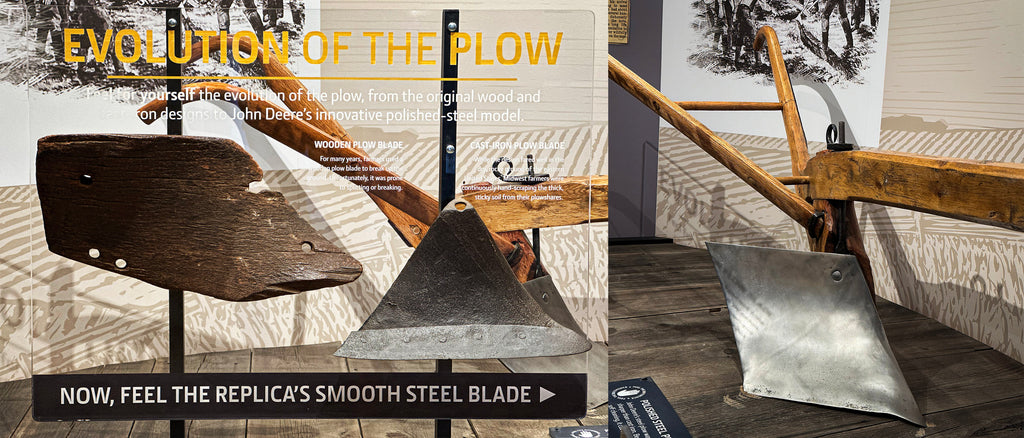


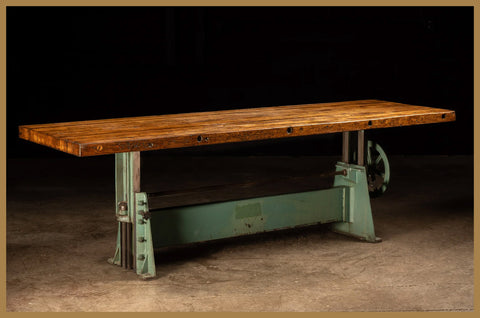
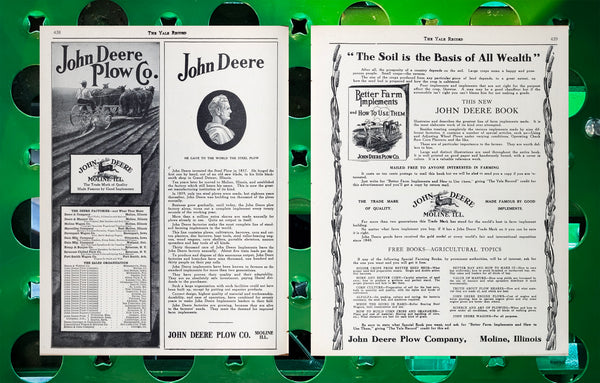
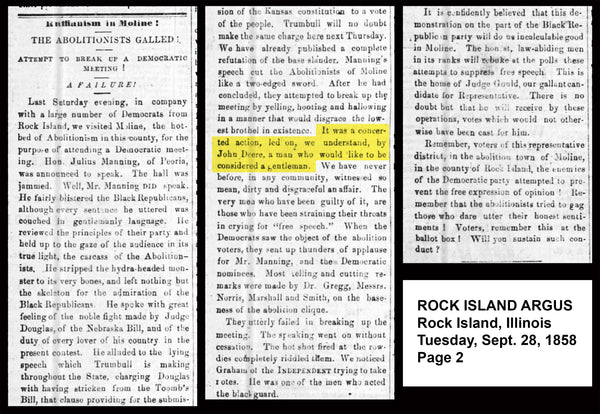

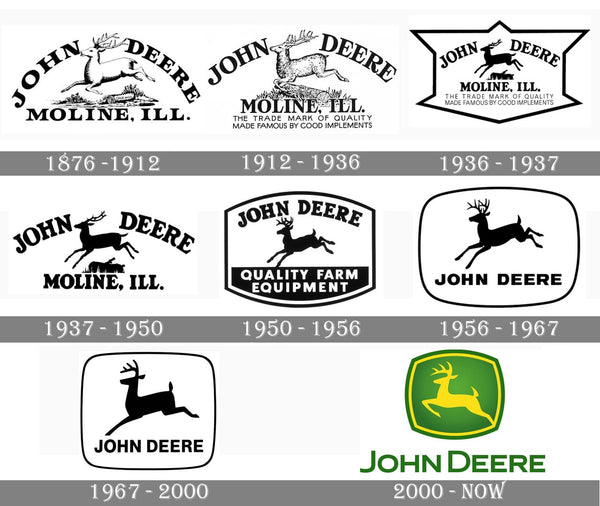



Leave a comment